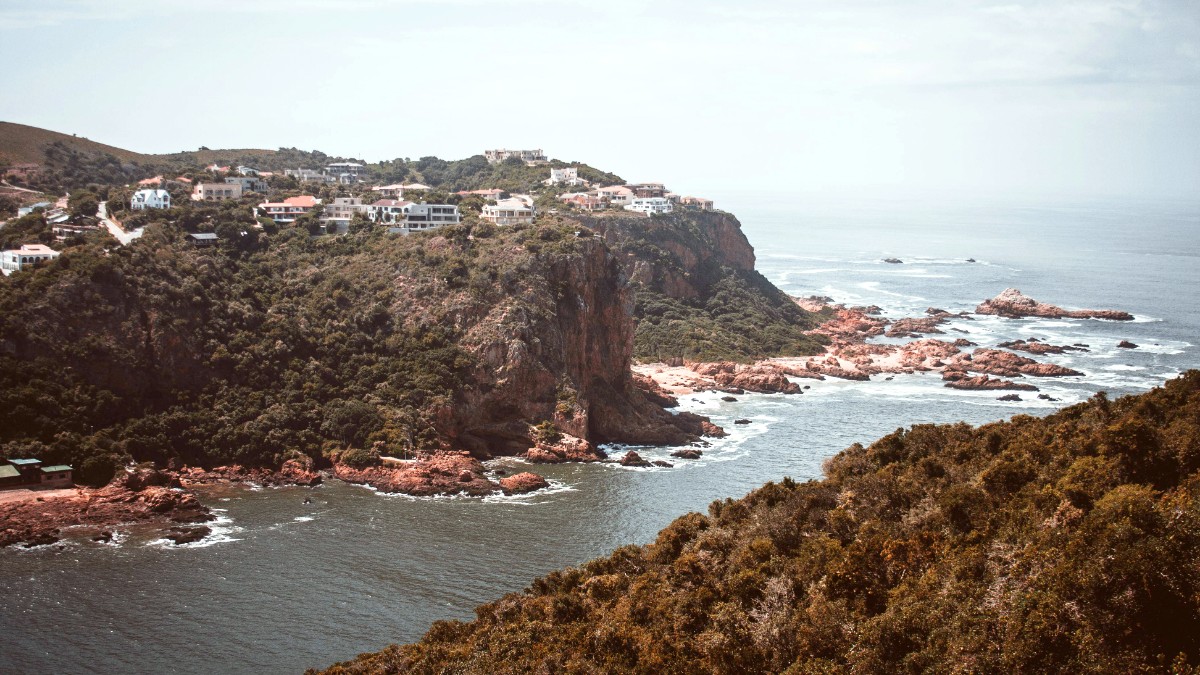
South Africa
Plettenberg Bay is strategically positioned along the N2 highway, a central artery of the Garden Route. Plett sits at the heart of this region, approximately 600 kilometers (370 miles) east of Cape Town and 240 kilometers (150 miles) west of Gqeberha (Port Elizabeth). The town is cradled by the majestic Tsitsikamma Mountains to the north and the expansive Indian Ocean to the south. The coastline around Plettenberg Bay includes beautiful beaches, dramatic cliffs, and an unique lagoon formed by the confluence of the Keurbooms and Bitou Rivers. This estuary is a haven for birds and marine life, offering a calm counterpoint to the wild ocean. This varied geography sets the scene for a wide array of activities, from deep-sea adventures to forest explorations.
Plettenberg Bay's history is as rich and layered as its landscape. Evidence of early human occupation dates back over 120,000 years, found within the ancient caves of Robberg Peninsula. These archaeological sites chronicle a long history of Stone Age inhabitants thriving on the abundant marine resources of the bay.
The modern history of Plettenberg Bay began to take shape with the arrival of Portuguese navigators. In 1576, Manuel da Perestrello named the bay "Bahia Formosa," meaning "Beautiful Bay," a name that still resonates with visitors today. European settlement began more formally in the late 18th century. He renamed the bay Plettenberg Bay in 1778.
Miles of golden beaches, including Central Beach, Lookout Beach, and Keurboomstrand, offer opportunities for swimming, sunbathing, and long walks. The dramatic cliffs and hiking trails of Robberg Nature Reserve grant unparalleled coastal views and a chance to observe a thriving Cape Fur Seal colony. The serene Keurbooms River and Lagoon are perfect for calm water activities.
Plett is a premier destination for marine wildlife. Southern Right Whales visit the bay from June to November, offering spectacular viewing opportunities from shore or boat. Dolphins are often present year-round. Nearby sanctuaries like Monkeyland, Birds of Eden, and Jukani provide ethical encounters with a variety of rescued animals.
From casual beachside eateries to fine dining establishments, options to satisfy every palate.
Whether hiking, surfing, kayaking, or stand-up paddleboarding, Plett has options. The world's highest commercial bungy jump at Bloukrans Bridge is a short drive away.
The Plett Wine Route has unique cool-climate wines for tasting.
Despite its popularity, Plettenberg Bay has a relaxed, friendly atmosphere. It is a place for unwinding and connecting with nature.
Plett can be an adventure playground or a tranquil retreat, based on your preferences.
Whether hiking, surfing, kayaking, or Stand-up paddleboarding, Plett has options. For the adrenaline seeker, the world's highest commercial bungy jump at Bloukrans Bridge is a short drive away. From casual beachside eateries to fine dining establishments, you will find options to satisfy every palate. The emerging Plett Wine Route offers unique cool-climate wines for tasting.
Despite its popularity, Plettenberg Bay has a relaxed, friendly atmosphere. It is a place where you can unwind, connect with nature, and enjoy the pace of coastal life.
From casual beachside eateries to fine dining establishments, options to satisfy every palate. The emerging Plett Wine Route offers unique cool-climate wines for tasting.
Plettenberg Bay provides visitors an unforgettable experience, blending natural wonders, adventure, and a welcoming community. This guide will share details to plan your ideal visit.
Plettenberg Bay has a mild, temperate climate, often compared to the Mediterranean, with rainfall occurring year-round, though generally more in summer.
Plettenberg Bay's coastal weather shifts quickly. Even on sunny days, a Light jacket or Windbreaker works well for evenings or unexpected cool breezes. A Packable rain jacket is a smart addition to your luggage.
Warmest temperatures, ideal for beach activities and water sports. Ocean temperatures are inviting. Long daylight hours are good for outdoor enjoyment.
Mild conditions, heat subsides. Rainfall decreases. Perfect for outdoor activities like hiking and exploring reserves. Natural beauty shines as summer crowds thin.
Cooler, drier conditions with many sunny days. Good for whale watching. Hiking is popular with crisp air and clear skies. Nights can be chilly.
Temperatures begin to rise. Wildflowers bloom across the fynbos, creating a colorful display. Conditions are excellent for all outdoor activities, and whale watching continues through October. The weather is generally settled and pleasant, making it a favored time for moderate temperatures and natural beauty.
Mid-December to January, Easter Holidays, July school holidays. Most crowded times, with busy beaches, restaurants, and attractions. Prices for accommodation and activities are highest. Expect longer waits and a bustling environment.
February - March, September - November. Pleasant weather, fewer crowds than peak times. Prices for accommodation and activities are often slightly lower, offering good value. Periods are good for outdoor activities like hiking and for early or late whale watching.
May - June, August. Fewest crowds and lowest prices, making them good for budget travelers and those seeking tranquility. Still a good time for hiking, with cooler temperatures. Some smaller establishments might close for a short break.
A pair of Binoculars enhances the experience. Consider a pair of Nikon ProStaff binoculars for clear viewing.
A camera with a good zoom lens is highly recommended for capturing clear images of distant subjects.
Even on warm days, sea breezes can be cool, so a light jacket or sweater is good for boat tours.